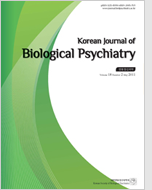
- Past Issues
- e-Submission
-

2021 Impact Factor 1.766
5-Year Impact Factor 1.674
Editorial Office
- +82-01-9989-7744
- kbiolpsychiatry@gmail.com
- https://www.biolpsychiatry.or.kr/

2021 Impact Factor 1.766
5-Year Impact Factor 1.674
Korean Journal of Biological Psychiatry 2013;20(1):12-20. Published online: Jan, 1, 2013
Objectives :
We investigated the tolerability, safety, and treatment response to flexible-dose paliperidone ER in patients with non-acute schizophrenia in whom previous antipsychotic drugs were ineffective.
Methods : This 24-week interim analysis of the 48-week multicenter, prospective, open-label study assessed effectiveness using the Positive and Negative Syndrome Scale (PANSS), Clinical Global Impression-Schizophrenia-Severity (CGI-SCH-S) Scale, Personal and Social Performance (PSP) and Drug Attitude Inventory (DAI). Safety and tolerability were assessed using the Drug-Induced Extrapyramidal Symptoms Scale (DIEPSS) and Liverpool University Neuroleptic Side Effect Rating Scale (LUNSERS).
Results : Effectiveness was assessed in 169 patients. Significant improvement in the PANSS total score was observed by week-1 and continued until week-24. The response rate was 33%. The CGI-SCH-S and PSP total scores significantly improved during 24 weeks ; however, no change occurred in the total DAI. Fifty-nine percent of patients reported adverse events, of which extrapyramidal symptoms were the most frequent (19.0%). The DIEPSS and LUNSERS scores were improved after 24 week.
Conclusions : Switching to the flexible-dose paliperidone ER from an ineffective antipsychotic drug was safe, tolerable, and showed a good treatment response in Korean patients with schizophrenia.
Keywords Paliperidone ER;Tolerability;Safety;Effectiveness;Schizophrenia.